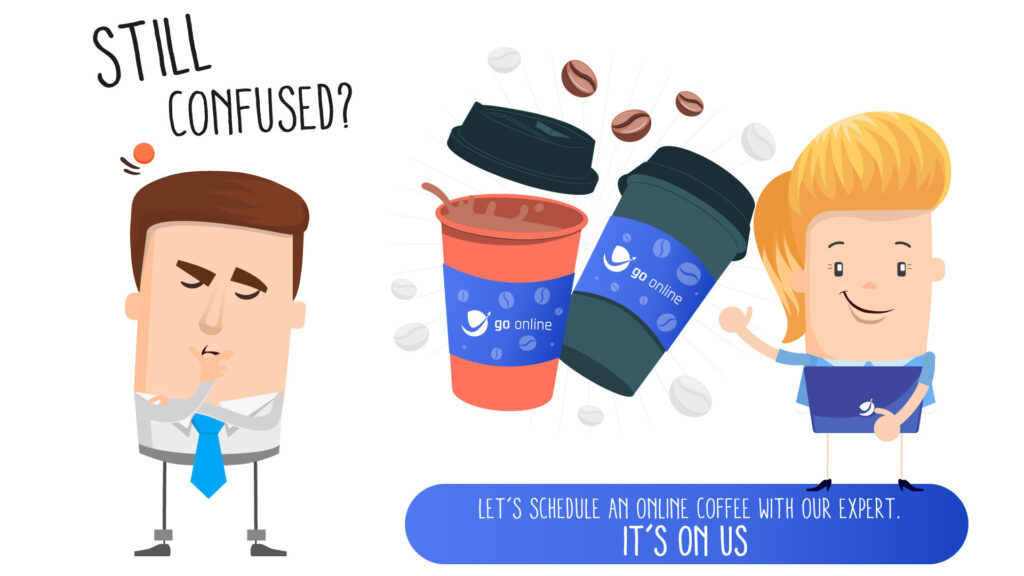Choosing the right technology stack (tech stack) is one of the most important decisions a startup company should make. Shifting to another tech stack will be difficult and costly if you make the wrong choice. This article discusses the best tech stacks for a startup in 2022. It also explains some important facts, such as what to consider when choosing a tech stack, the results of selecting the right and wrong tech stacks, what tech stacks leading companies use, and outdated ones startups should avoid.
The importance of tech stacks in software development
What is a tech stack?
A tech stack is also known as a solution stack or technology infrastructure. It is a collection of all the technologies stacked together to build easily maintainable and scalable software applications. It defines the application type you can develop like a social media app, e-commerce app, etc., the customizations you can do, and the required resources.
What are the elements of a stack?
A typical tech stack includes technologies for developing the front-end and back-end, databases, servers, and operating systems. Modern tech stacks include more advanced layers like Business Intelligence (BI) tools and data analytics capabilities to get deeper insights into your application behavior. Additionally, tech stacks include microservices, containerization support, and performance monitoring tools to detect resource-heavy areas of an application.
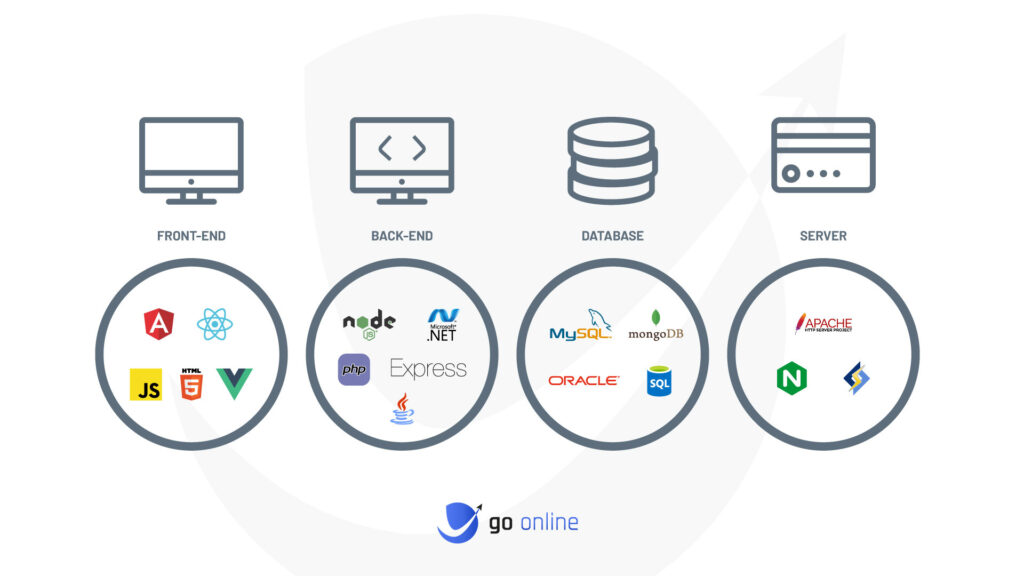
Front-end frameworks
We use front-end frameworks to build the user interface of an application. They can include common languages like HTML, JavaScript, and CSS stylesheets to more popular frontend frameworks such as React, Bootstrap, AngularJs, BackboneJs, VueJs, and EmberJs.
Back-end frameworks
A back-end framework is a collection of technologies for developers to build application back-end functionalities like application classes, functions, communication with a database, API requests, etc. Some popular back-end technologies include Python, Django, Microsoft.NET, Java Springboot, and NodeJs.
Databases
Databases are critical components of a tech stack that enables storing all your information. Tech stacks provide popular databases such as MongoDB, MySQL, and PostgreSQL.
Servers
A server serves your application content to the users by handling HTTPS requests from the client, directing the requests to the databases, and handling the responses. Most commonly used servers include Apache HTTPd, Nginx, and IIS.
Operating systems
Modern tech stacks support development with any operating system or platform. You can choose one depending on what devices your applications should be built for. Popular operating systems in tech stacks include Windows, Linux, iOS, and Andriod.
Why is the tech stack an important decision for startups?
When you build everything from the beginning, preparing your application to get more traffic with time is essential. You will not face horizontal and vertical scaling issues when application traffic increases if you choose a tech stack with scalable databases and frameworks from the initial stages.
A tech stack should include everything you need. If not, adding other parts or changing the stack later will be difficult. Besides, a startup can avoid investments in unnecessary technologies and resources by choosing the right tech stack. It will help them save costs.
Moreover, a tech stack is important to leverage the already existing expertise in your team, hire people who are experts in individual technologies or use an outsourcing company with professionals with the right expertise. It reduces the time to learn new technologies, speeding up the development process and introducing your products faster to the market.
What are the most popular tech stacks for startups in 2022?
Following are the popular tech stacks that are ideal for startup companies.
MEAN
MEAN stack consists of the following technologies
- M – MongoDB, the NoSQL database
- E – Express.js framework for backend
- A – Angular.js for front-end development
- N – NodeJS server-side javascript-based technology
MEAN stack is a free, open-source, and end-to-end JavaScript tech stack. It means you only need a single programming language to develop the entire stack of your product, with the ability to reuse the code across your application. MEAN stack is suitable if you want to develop scalable and responsive applications faster with JavaScript expertise in your team as well as javascript expertise from outsourcing partners.
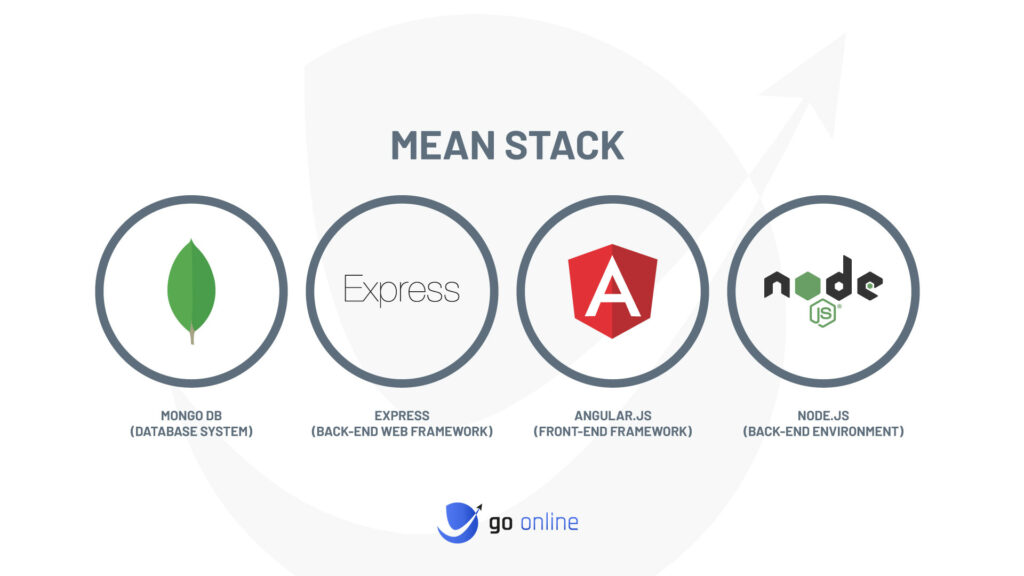
MERN
MERN is another widely-used tech stack similar to the MEAN stack, where you use React instead of AngularJS for front-end development. It includes the following tech stack.
- M – MongoDB, the NoSQL database
- E – Express.js framework for backend
- R – React for front-end development
- N – NodeJS server-side javascript-based technology
The use of React makes it suitable for developing robust and responsive, single-page web applications.
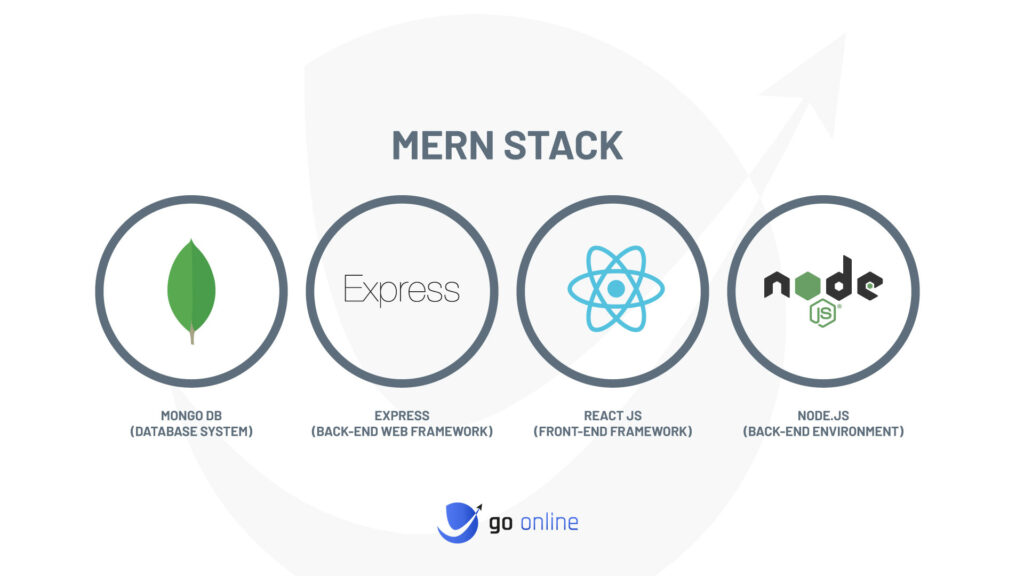
MEVN
MEVN is another variation of the MEAN stack which uses the popular front-end web framework Vuejs as the front-end framework instead of ReactJS. It includes the following tech stack.
- M – MongoDB, the NoSQL database
- E – Express.js framework for backend
- V – VueJS for front-end development
- N – NodeJS server-side javascript-based technology
VueJs combines features of React and Angular allowing you to build reactive apps with optimized rendering.
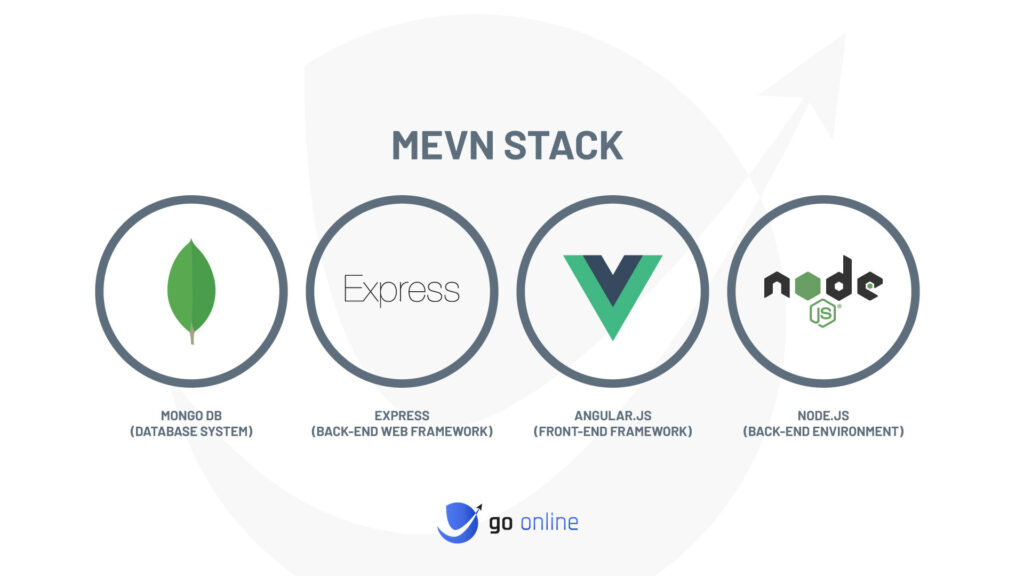
LAMP
LAMP is another popular open-source tech stack that consists of the following technologies.
- L – Linux operating system
- A – Apache server
- M – MySQL database
- P – PHP programming language
You can develop dynamic web applications with the lamp stack. The modifications to the stack are also easy. For example, you can use Python or Perl instead of PHP and Windows instead of Linux.
Flutter
Flutter is an open-source tech stack for building apps with beautiful UIs and runs on multiple platforms using only a single codebase. It consists of the Dart programming language, Flutter engine based on C++, Foundation Library, and frameworks. The features of Flutter make it easy to learn, release products faster to the market, and send updates to the cross-platform app easily.
Ruby on Rails (RoR)
Ruby on Rails is an open-source full-stack web framework that includes all the technologies required to build powerful web apps. Ruby provides a repository of “ruby gems,” a collection of libraries and frameworks like JavaScript, Bootstrap, Node.js, jQuery, CoffeeScript, Redis, MongoDB, etc., in the tech stack. RoR is ideal for building highly scalable applications efficiently.
.NET
Microsoft’s .NET allows you to build lightweight applications that run on Windows and Linux operating systems. A .NET tech stack typically consists of the following technologies.
- ASP.NET MVC (Model-View-Controller framework)
- AngularJS with TypeScript
- SQL Server
- IIS web server
- Microsoft Azure
Additionally, developers have the flexibility to use other open-source databases such as Mysql or Postgresql.
Serverless tech stack
This unique tech stack consists of a collection of cloud resources. For example, use AWS cloud formation templates to define the tech stack you want and lambda to run functions without managing servers.
What should startups consider when selecting a tech stack vs. using an outsourcing partner?

In this section, we will explain the important factors startup companies should look for in a tech stack before deciding whether to choose a tech stack or an outsourcing partner.
The cost
Consider all the costs associated with the tech stacks. For example, what is the budget to develop your application? Should the tech stack include costs for proprietary technologies? It will be cheaper for you to start if your tech stack includes only open-source technologies. However, you may have to integrate more sophisticated technologies depending on your project requirements. In addition, there can be ongoing maintenance and hosting costs depending on the tech stack you leverage.
Furthermore, think about the developer costs. If it is a new tech stack for developers, you may have to allocate some budget to provide essential training. Also, you may have to hire new developers. In that case, hiring good developers is time-consuming, costly, and demands expertise to do so.
In addition, there can be licensing costs, especially for commercial databases. If that is the case, it is good to hire an outsourcing partner who takes care of such complexities and effectively manages the budget on your behalf.
The project type and the size
The tech stack you choose depends on the type and size of your project. For example, consider whether it is a small, medium, or big complex project, a simple web app that targets a specific user base, a complex web app that targets users worldwide, etc.
If you are a startup that needs a simple one, then it’s better to look for a simple tech stack like the MEAN stack that uses only one language. It allows you to build the application’s Minimum Viable Product (MVP) faster. Moreover, consider if it is a mobile or a typical standalone web development project. Consider a tech stack specific to mobile app development if it is a mobile-only application.
The expertise of your team and the learning curve
If you already have a team of developers, see if you can match a better tech stack with their expertise. Your team should be competent in using all the technologies in the tech stack. If it is entirely new or most of the layers are new to them, consider how much time it takes to learn and adapt those technologies.
If the learning curve is high, it will affect your project delivery timelines. In such cases, startup founders may outsource a vendor with their tech stack expertise. Besides, the simpler the tech stack, the better, as complex tech stacks require people with more skills, which could be rare and expensive to find.
Scalability
Scalability is one of the most important things startups should consider from the beginning of their ventures. The Tech stack should support the future growth of the application. It will be difficult to achieve if the tech stack has limitations. Especially the databases need to be scalable if the app is data intensive. For example, NoSQL databases like MongoDB offers many scaling options. Additionally, think about vertical scalability; how easy it will be to introduce new features over time; and horizontal scalability; how easy it supports expanding to a larger user base in the future.
Most tech stacks that use cloud infrastructures like Amazon AWS and Microsoft Azure with autoscaling capabilities allow apps to scale to billions of users. It minimizes application downtimes and provides options for database scaling.
Time-to-Market
This is another important factor for a startup because the faster they enter the market, the faster they can compete with their competitors. Go for a tech stack where you can develop faster, excluding boilerplate code as much as possible. Consider how easy it will be to test the code for this factor. Tech stacks with good testing frameworks support faster testing cycles. Moreover, community support is a deciding factor on how fast you can release the app to production. When there is good community support, it helps developers a lot to find solutions for issues and resources to learn.
Maintenance
Select a tech stack that is easily maintainable. After you release the app to production, it should be maintained regularly with modifications and software updates to meet the performance standards, customer expectations, and many more. Open-source technologies are ideal if you want to avoid maintenance costs as they follow the reusability concepts to make code maintenance easier.
Additionally, completely serverless tech stacks remove the burden of maintaining the infrastructure as it is owned and managed by the service provider.
Security and Performance
Look for any security vulnerabilities before they could become severe problems for the application. It is more important if you are building applications that require high-level security. For instance, assume your app deals with sensitive private information like credit card information or medical histories. Then choose more secure frameworks that help meet compliance standards. API and Database security features must also be considered for such sensitive applications.
Community Support
Many open-source tech stacks have larger community support. Active community support for the tech stack means you can easily get support for any issues, and there is rich learning content. Therefore, developers do not have to waste days finding solutions to critical problems.
What are the consequences of selecting the wrong tech stack for a startup?
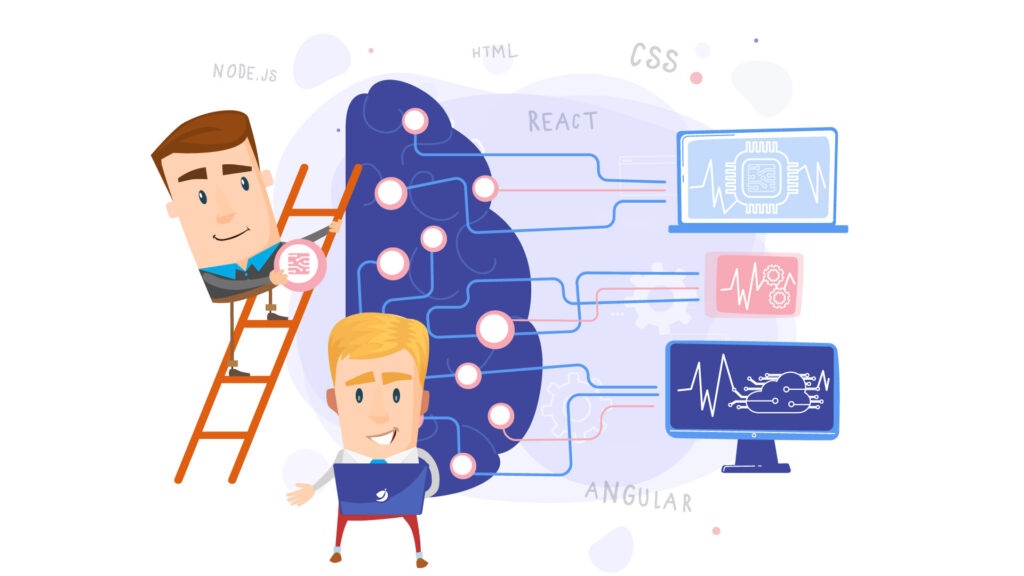
If you choose the wrong tech stack for your startup, it can impact your whole project. For example, if you had to change from one tech stack to an entirely different one that uses a new programming language, you would have to rewrite the code from scratch. You could do it in phases, but the entire process will be time-consuming and costly.
If the tech stack you have chosen cannot achieve your intended functionalities, bugs and issues may arise in the system with time. Furthermore, suppose it does not have enough support for scalability, and you test the application performance under varying user loads. In that case, when the application gets a larger user load, there is a higher possibility of causing unexpected errors and performance issues that trigger application downtimes.
However, suppose the tech stack is not flexible enough to address such issues in less time before deploying it to production. In that case, you will have to either change your deployment dates or deploy it to production, knowing such issues can arise anytime, ultimately leading to a bad user experience. As a startup, you must decide well as the revenues lost with such incidents could become unbearable.
In addition, time to learn the tech stack directly affects your project completion dates. If it is harder to learn and does not match the expertise of your team, you will not be able to complete the project on time.
What are the advantages of selecting the right tech stack?
Your startup can benefit from choosing the right tech stack for their project requirements in many ways.
- The right tech stack increases the productivity of the developers.
Learning and writing code is much easier when you have frameworks that automatically add code and provide in-built functionalities for code reusability. For example, tech stacks with ReactJS allow you to create highly reusable code. Once one developer designs a component, it can be reused across the code. With such reusable code, it is easy to build the Minimum Viable Product (MVP) scope and send it to the market for earlier user testing. Then add more functionalities according to the user inputs.
- Easy for startup founders to hire people with right expertise
With an understanding of the right tech stack for the projects in their minds, it is easy for startup founders to hire more people, leverage the existing expertise, or even hire a third-party service provider. Professionals in your team with expertise in the tech stack can help novice developers to catch up with their chosen tech stack.
- Provides good ROI
The right tech stack will be a good Return on Investment (ROI) for startups. Great performance and scalability mean you will likely expand your user base faster and avoid all the scaling issues since the beginning of your application execution.
- You can easily add extra functionalities to improve your product
You can introduce additional yet critical operations like performance monitoring to observe how your application behaves with time. You can also invent varying user loads and business intelligence and analytics tools that help you to get insights about your product from the beginning.
- Get a deeper understanding about your project infrastructure, software, hardware, and human resources
Knowing the right tech stack means you know what infrastructure, software, hardware, and human resources are in detail from the beginning. It saves you time in knowing such details in subsequent planning phases.
- Easier to expand your product with new features
If you have a suitable tech stack, you can introduce new features without much effort and without impacting the existing functionalities.
What are some tech stacks used by leading tech companies?
Here we discuss the main technologies used by famous tech companies like Facebook, Uber, and Airbnb. You will notice that these companies use a combination of popular open-source tech stacks we explained in their different components. Almost all have leveraged cloud computing to make their apps scalable to millions of users worldwide.
Facebook is the most popular social media website. The following summarizes some of the main technologies used in different application components.
- Frontend – ReactJS, JavaScript, HTML, and CSS.
- Backend- PHP, GraphQL, Hack
- Databases: HBase, Cassandra, RocksDB, Beringei, Memcached
- Server – Apache
Uber
Uber is a famous taxi service available worldwide. Its tech stack includes:
- Frontend – React, Javascript, JQuery, BackboneJs
- Backend – Node.js Python, Java, Go, Objective-C, Swift
- Databases – MongoDB, Cassandra Redis, MySQL. PostgreSQL, Riak
- Server – NGINX
Airbnb
The tech stack of this popular accommodation booking system includes:
- Frontend – Ruby, React, JavaScript
- Backend – Ruby on Rails, Kotlin, Swift, GraphQL
- Databases – Amazon RDS, MySQL.
- Server – NGINX
Airbnb leverages cloud computing and tools like Kafka, Elastic search, and Hadoop.
Pinterest enables users to share images. The app uses the following technologies in its tech stack:
- Frontend – React, Javascript
- Backend – Java, Python, Django, Go, NodeJs
- Databases – MySQL, HBase, Redis, RocksDB
- Server – NGINX
Also, Pinterest uses containerized technologies like Docker, Amazon ECR, and tools like Kafka, Elastic search, and Hadoop.
Snapchat
This popular communication app uses the following technologies:
- Frontend – Bootstrap, AngularJS, Javascript, JQuery, React
- Backend – Java, Kotlin, Objective-C, Swift
- Databases – MySQL, DocumentDB, MongoDB, Redis
Netflix
Netflix is the world’s leading streaming service, allowing users worldwide to watch movies, TV series, etc. The technologies they use include:
- Frontend – React, Javascript
- Backend – NodeJs, Python, Java, Swift
- Databases – MySQL, PostgreSQL, Oracle, Cassandra
Instagram is the most popular photo-sharing and social networking app that allies users to take and share pictures, and videos, add stories, do online businesses, etc. The technologies they use include:
- Frontend – React, React Native, Javascript
- Backend – Python Django, Objective-C, GraphQL, Java
- Databases – PostgreSQL, Memcached, Cassandra
- Server – NGINX
Tech stacks to avoid or that are outdated
Tech stacks that include programming languages without much use should be avoided. For example, according to the StackOverflow developer survey in 2021, Perl is used by only a few applications, and frameworks like Drupal and Hadoop have a lower usage than other popular frameworks.
Such technologies may not be updated frequently, and it will be difficult to integrate systems with other technologies. Therefore, always go for frameworks supported and used by a large community.
Conclusion
A tech stack is one of the most important decisions for a startup company, as it can make or break the code. As explained in this article, there are several things you should consider, such as the project type, cost, team expertise, time-to-market, security, and scalability, before deciding on the tech stack. If you have chosen the right one, it will bring a lot of benefits. Otherwise, it will be a complete waste of time.
